Mount Athos – Cruising by the Monasteries
This is post #4 from the Greece portion of last spring’s Adventures Abroad Via Egnatia tour led by the Canadian who knows more about Greece than most Greeks, our friend Victor Romagnoli. In the last post we visited the UNESCO World Heritage Site of Philippi and in this one we’ll see another. When Victor and I were planning the itinerary for this tour we both agreed that the monasteries of Mount Athos would warrant a full day on the tour. For me, seeing Mount Athos was so high on the agenda that I used a photo of one of the monasteries as the featured image on my post promoting the trip. Even though the weather was not as cooperative as I would have hoped, it was still a once in a lifetime experience that I look back on with very fond memories. Here’s why seeing the monasteries of Mount Athos should be on every traveller’s bucket list.
History of Mount Athos
Mount Athos as the name implies is in fact a mountain, a quite sizeable one by Greek standards, at 2,033 metres (6,670 feet), made all the more impressive because it rises straight out of the Aegean Sea at the tip of a narrow peninsula of the same name. Although there are references to settlements here in classical Greek times, there is very little archaeological evidence to support that. Mythology and early Christian narratives is another story. Athos was one of the giants who fought the Olympian gods during what is known as the Gigantomachia and the mountain named after him came into being when he hurled a gigantic stone at Poseidon and missed. Another version has Poseidon creating the mountain after burying Athos under it. Christian myth has the Virgin Mary and St. John the Evangelist being storm stayed here on their way to Cyprus, with the Virgin going ashore, being overwhelmed by the beauty of the place and asking her son to make it her garden. He granted her wish and from that time onward Mary was the only woman ever to be allowed to visit the Garden of the Mother of God. That certainly may help explain why it has been revered as the Holy Mountain from at least the time of the Emperor Constantine I.
When the monks started arriving on Mount Athos is unclear. There is evidence that monks from Egypt arrived after the Islamic conquest of that country in the seventh century, but raids by Saracen pirates from Crete in the 9th century left the peninsula deserted for a time. The first documented monk to arrive was Euthymius the Younger in around 860, but he lived as a hermit so didn’t found a monastery. That task fell to Athanasius the Athonite when he founded the Great Lavra in 963 and began the unbroken history of monastic life on Mount Athos peninsula. The Great Lavra remains the oldest, largest and primary of the twenty monasteries still in operation today.
Athanasius had a great relationship with the Byzantine Emperors who considered him to be a man of great piety and wisdom. This respect for him led directly to the first of a number of charters that have given the monasteries of Mount Athos a unique position vis a vis both the Orthodox Christian church and the government of Greece. The monasteries are independent of all Orthodox church structure and report only to the Ecumenical Patriarch in Istanbul. Readers may recall that during the Istanbul portion of this trip we passed by the residence of the current Patriach Bartholomew. Likewise, the Greek government permits the peninsula to operate as a semi-autonomous state within the country. It is this existence outside the laws of Greece and the EU that permit it to maintain its stricture against the presence of women and children within the Mount Athos territory.
There is no need to go into any more detail about the monasteries per se other than to note that over the last 1,000 years they have attracted people from all over the Christian world and beyond. Many of the monks have proven to be not only great theologians, but talented artists and architects as well. The monasteries are repositories of some of the most important art works in the Orthodox church. It was this combination of factors that led to Mount Athos being inscribed as a UNESCO World Heritage Site in 1988 with this as one of the criteria –
The transformation of a mountain into a sacred place made Mount Athos a unique artistic creation combining the natural beauty of the site with the expanded forms of architectural creation. Moreover, the monasteries of Athos are a veritable conservatory of masterpieces ranging from wall paintings (such as the works by Manuel Panselinos at Protaton Church ca. 1290 and by Frangos Catellanos at the Great Lavra in 1560) to portable icons, gold objects, embroideries and illuminated manuscripts which each monastery jealously preserves.
As far as I know, this is the only one of over 1,100 UNESCO World Heritage Sites that more than half the world’s population is forbidden to enter and since women make up well over half of our Via Egnatia group we’ll have to find another way of appreciating Mount Athos. Fortunately there is an alternative. Victor has booked us on a three hour boat tour that will take us from the ancient port of Ouranoupoli down the western side of the peninsula almost to the tip of the Mount Athos peninsula and back. Along the way we will see eight active monasteries and the Holy Mountain. I can’t wait so let’s get on board.
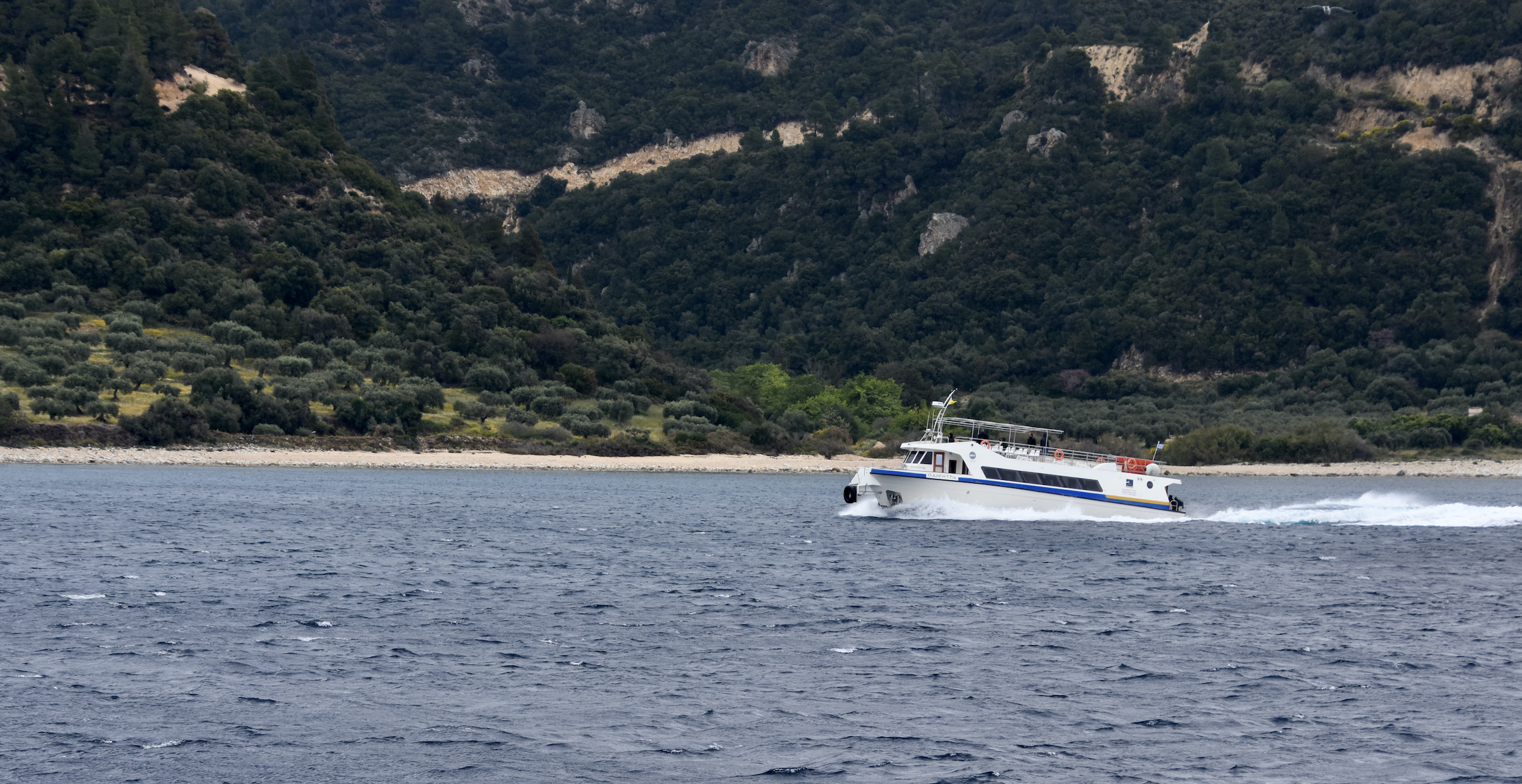
The drive from Kavala, where we spent the previous night,to Ouranoupoli is quite scenic, especially when we turn off from the main highway to Thessaloniki onto the Halkidiki Peninsula of which the Mount Athos peninsula is one of three smaller land masses that project like fingers into the Aegean Sea. Along the way we pass by the town of Stagira, birthplace of Aristotle. Ouranoupoli is a coastal town near the ancient city of Uranopolis, which was largely settled by Greek refugees from Turkey in the 1920s. Today it is known as the gateway to Mount Athos and is primarily a resort town, one of many on the Halkidiki Peninsula. Its main attraction is the Tower of Prosforion which is an 11th century Byzantine structure that was added to by the Ottomans in the 15th century. You can see it in the photo above as we pull away from the small harbour heading toward the Mount Athos peninsula.
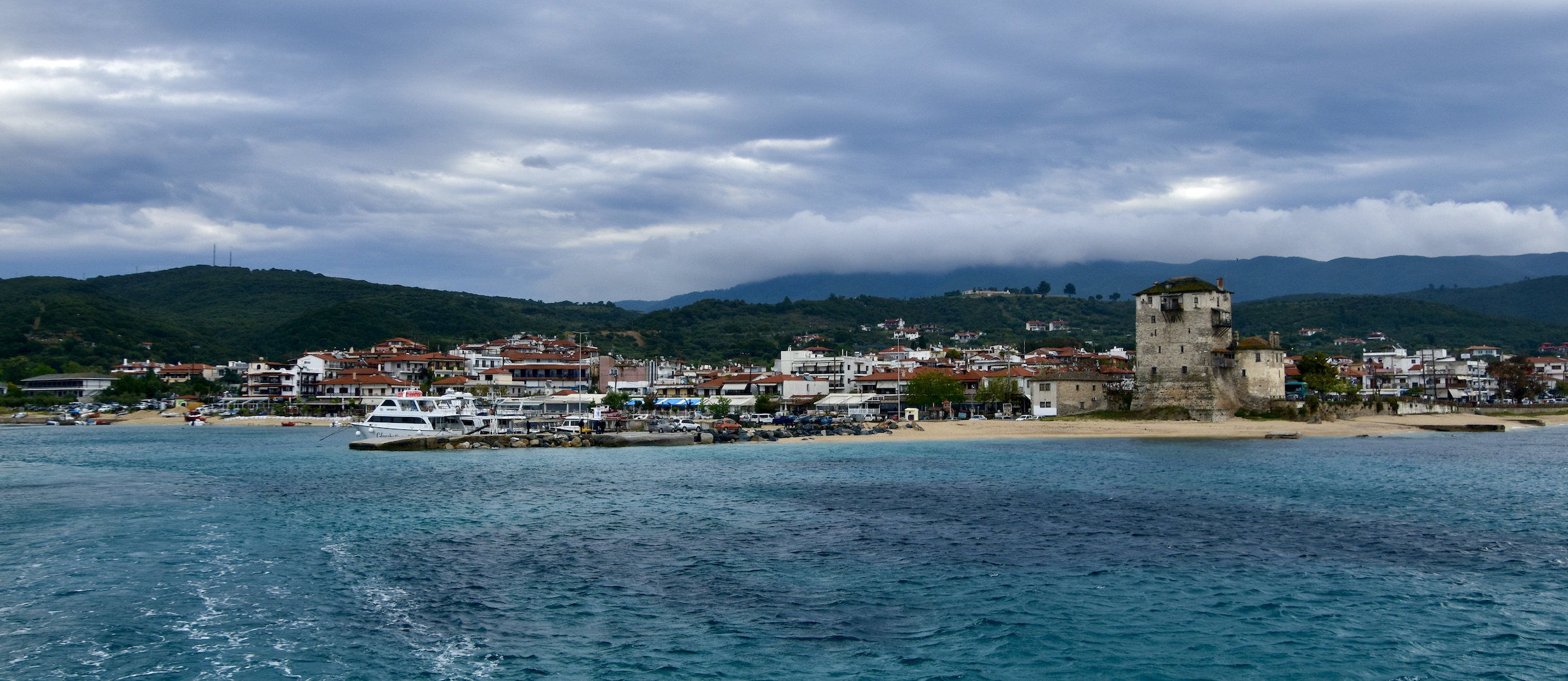
You can also see that the weather is overcast and frankly it was quite chilly for the time of year, but a little temporal adversity was not going to stop me from seeing the fabled monasteries of Mount Athos.
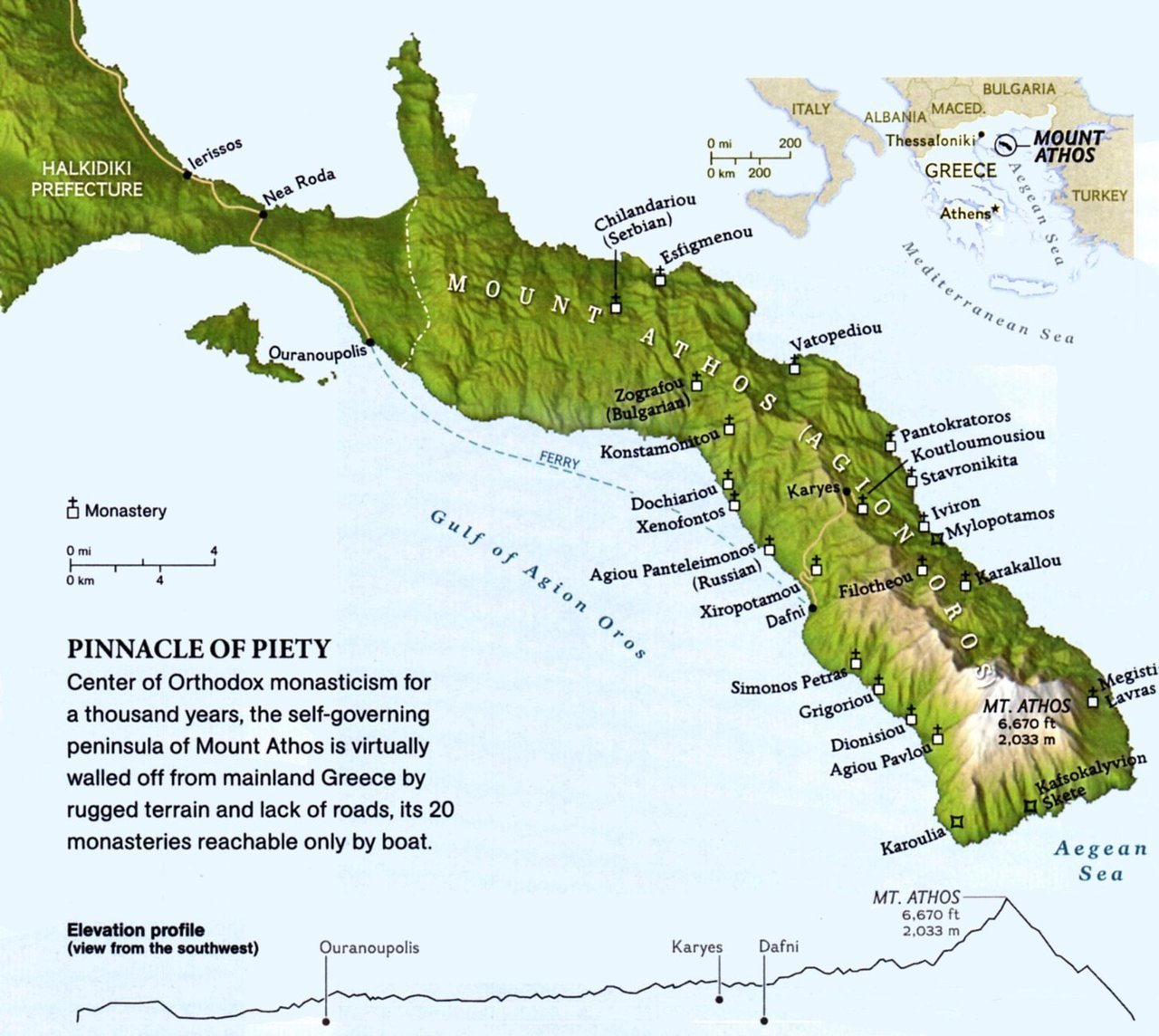
This is a map of Mount Athos peninsula showing the location of the twenty active monasteries. The dotted line just outside Ouranoupoli marks the boundary of the self-governing territory and it is an actual wall that prevents any wandering female goats or sheep from accidentally getting into the forbidden area. The map is incorrect in saying there are no roads into Mount Athos. There are in fact very primitive roads connecting all the monasteries and I did see vehicles moving along them during our cruise.
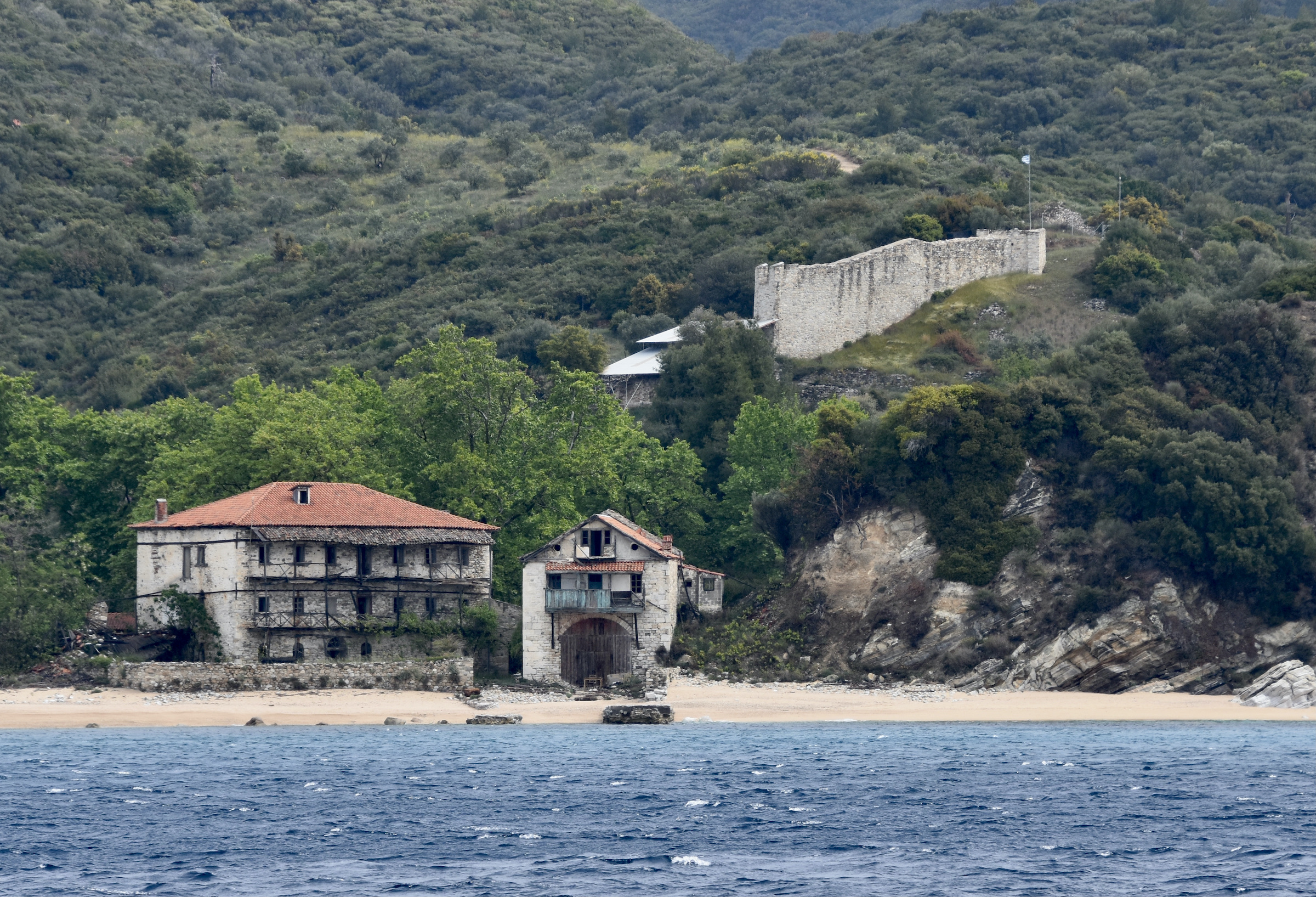
I’m not sure if the apparently abandoned building at the base was a monastery or not as it doesn’t show up on any map of the monasteries I have seen.
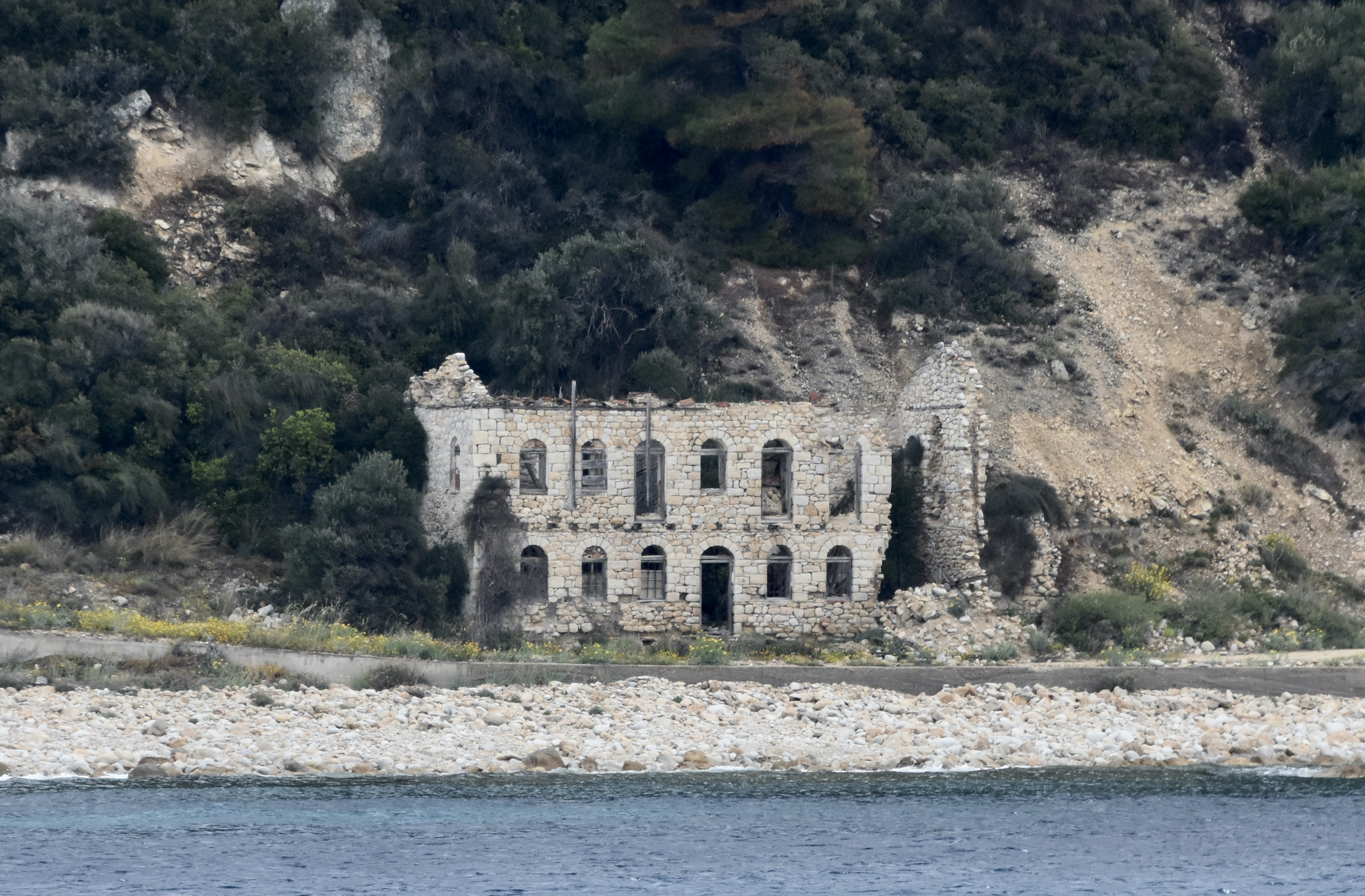
Neither does the next building we come across which is definitely a ruin. At the beginning of the 14th century there were 300 monasteries on Mount Athos, but constant piratical raids reduced the numbers to only 35 by the end of that century. In the 20th century the number was down to twenty with less than 1,200 monks, but since then there has been an apparent resurgence of piety in the Orthodox church and the numbers now exceed 2,000 and are climbing.
We actually sail a fair distance from the wall before seeing the next monastery, one of considerable size, but also apparently abandoned.
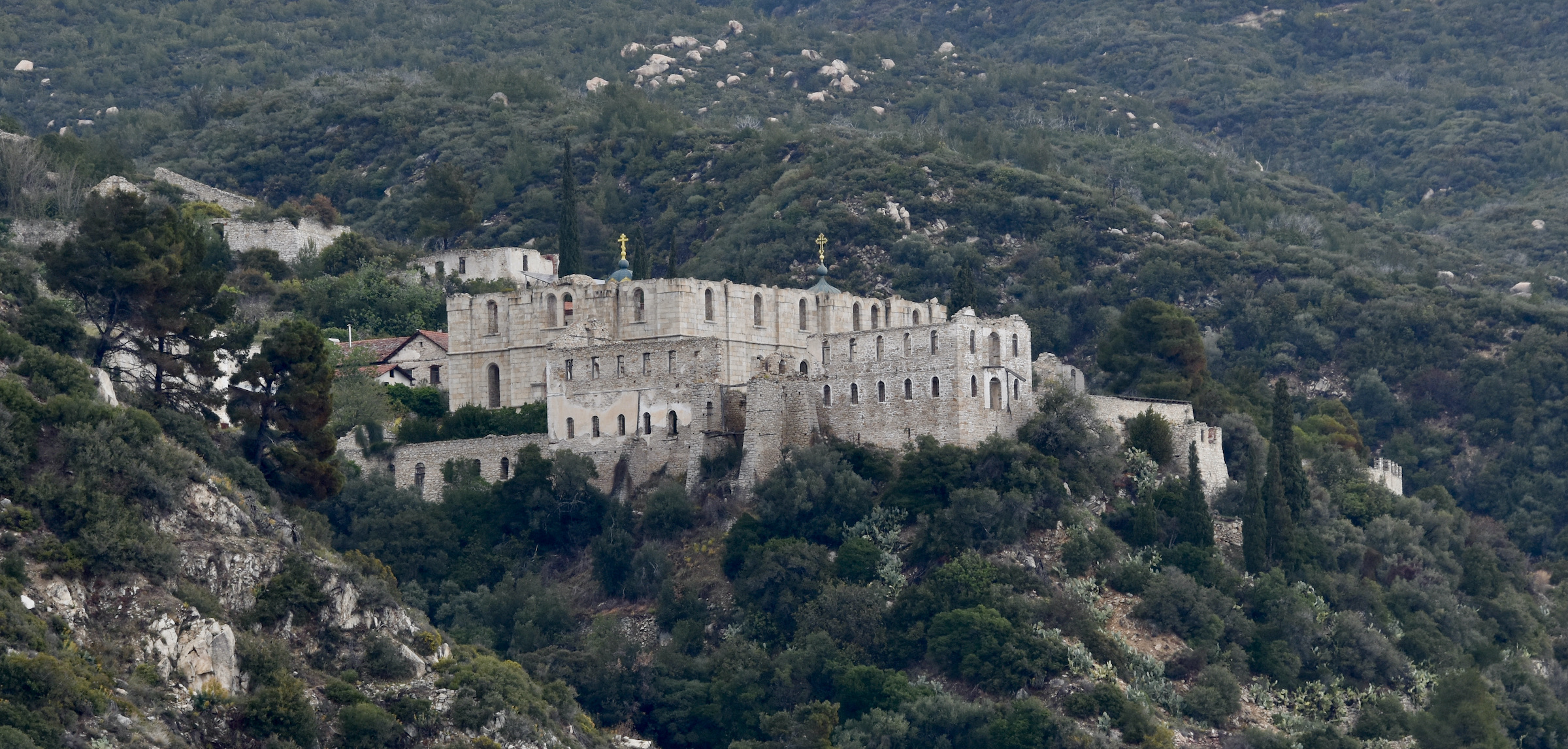
Before coming to the first active monastery we pass one of the landing areas where supplies are brought by boat and then transported by vehicle to the monasteries that are not located on the coast. You can see from the solar panels that the monks do not eschew all the hallmarks of modern technology.
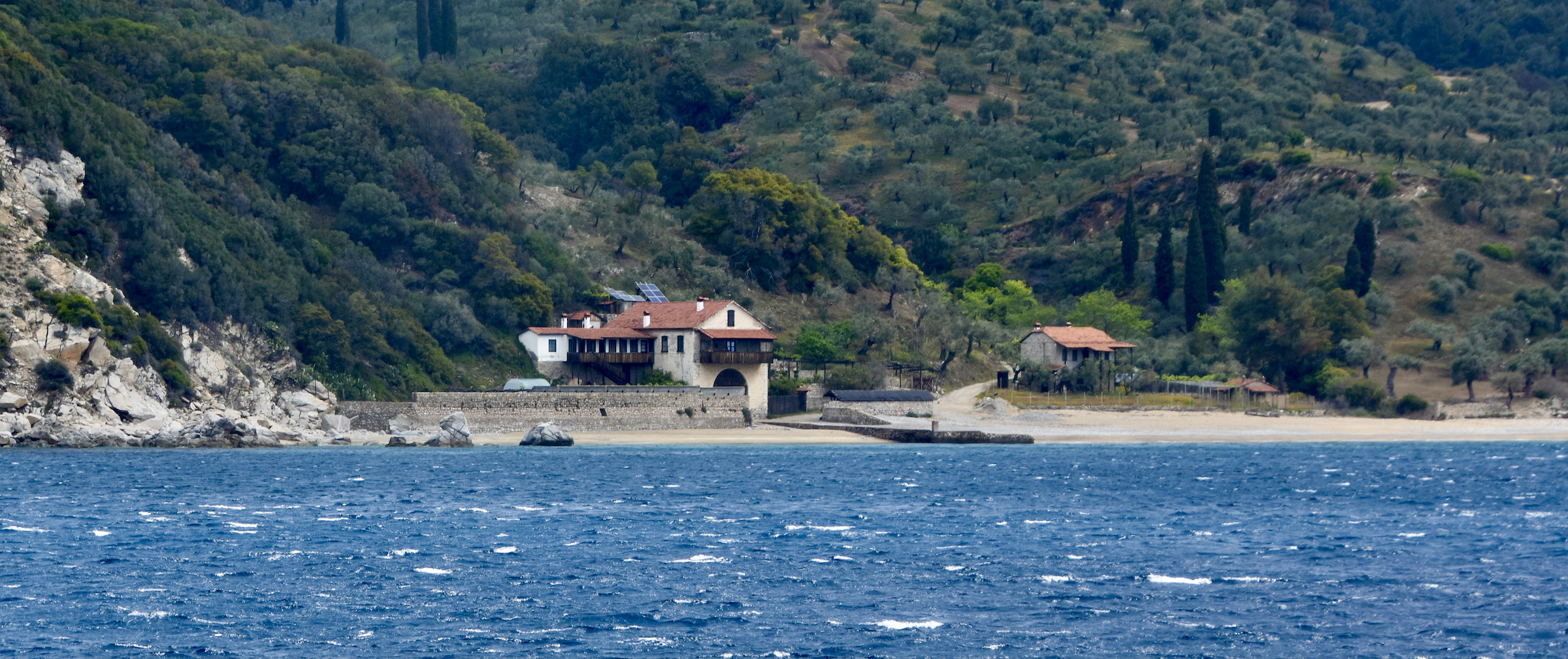
We also get our first glimpse of Mount Athos which is going to play peekaboo with us for the entire cruise.
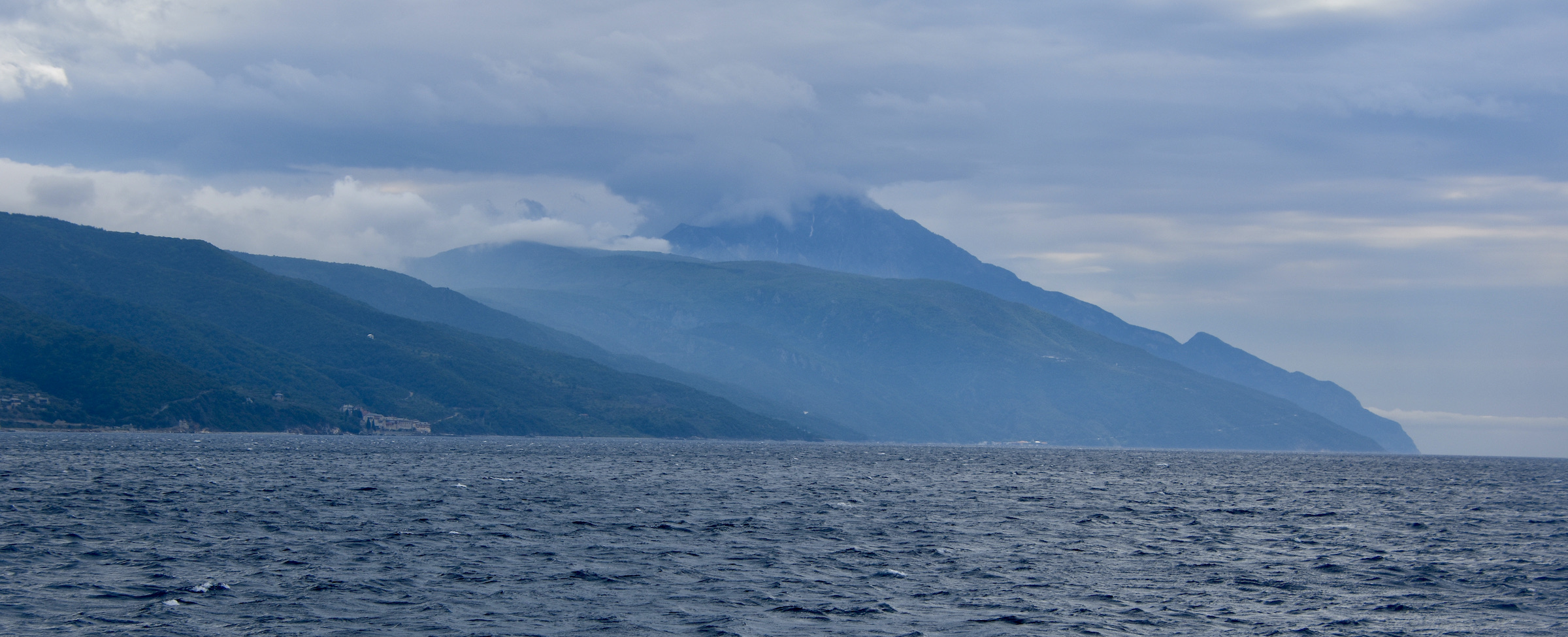
We finally pass by, at a proscribed distance, the first active monastery, Dochiariou which dates back to the 11th century and is dedicated to the archangels Michael and Gabriel. Despite its ancient roots this place is very much a 21st century operation. The monks are producing a great variety of natural incense including frankincense and myrrh, two of the gifts of the Magi. You can order them from the website by clicking on the link above.
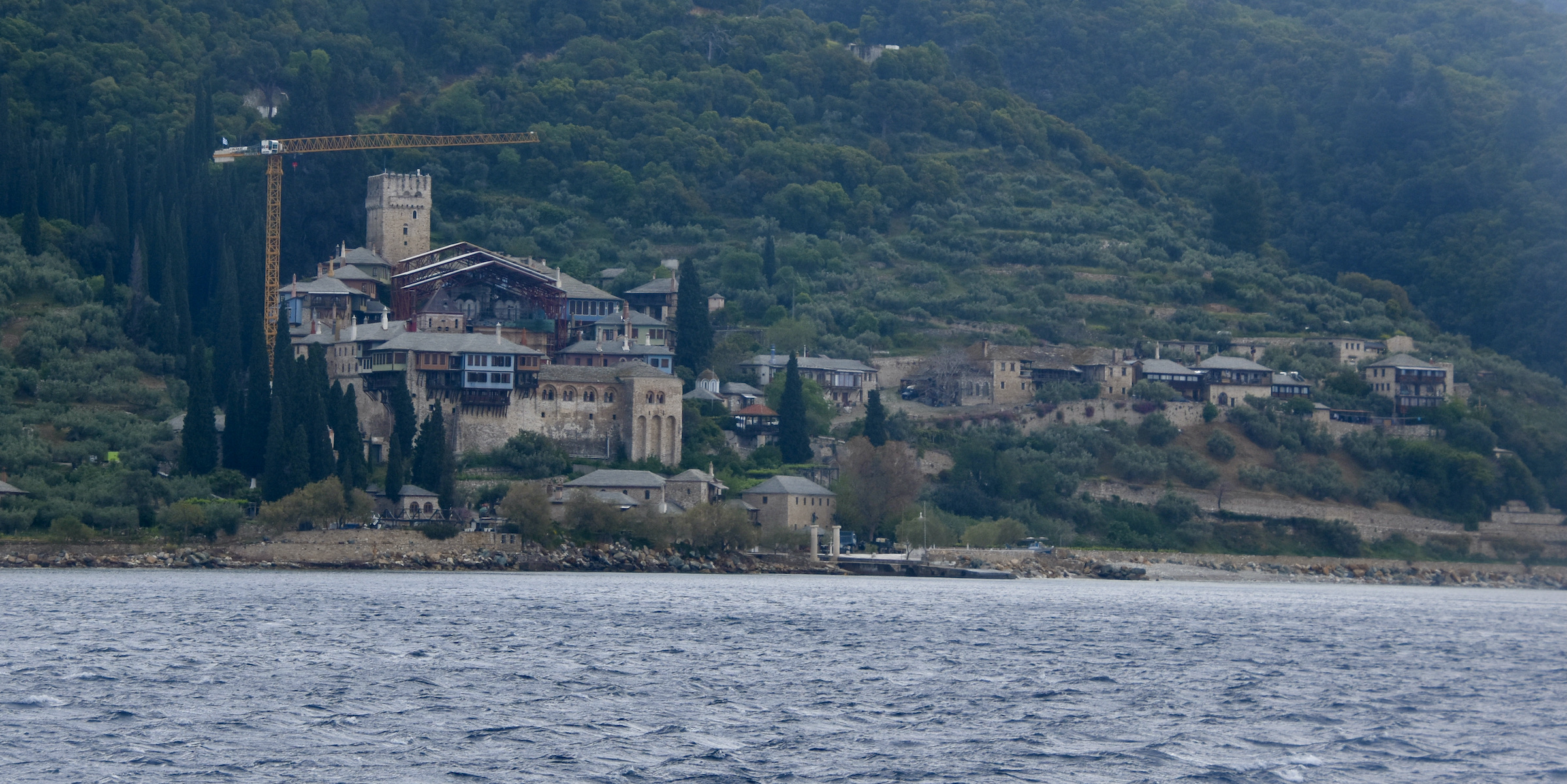
We now start seeing the monasteries at fairly regular intervals. Next up is Xenophontos monastery which was founded in 998 and houses many valuable treasures which you can view on its website. This monastery is also known for its woodworking skills and undertakes commissions from other monasteries and churches throughout the Orthodox world. By now I’m starting to realize that these places are far more than just places of refuge and prayer, but substantial operations in their own right.
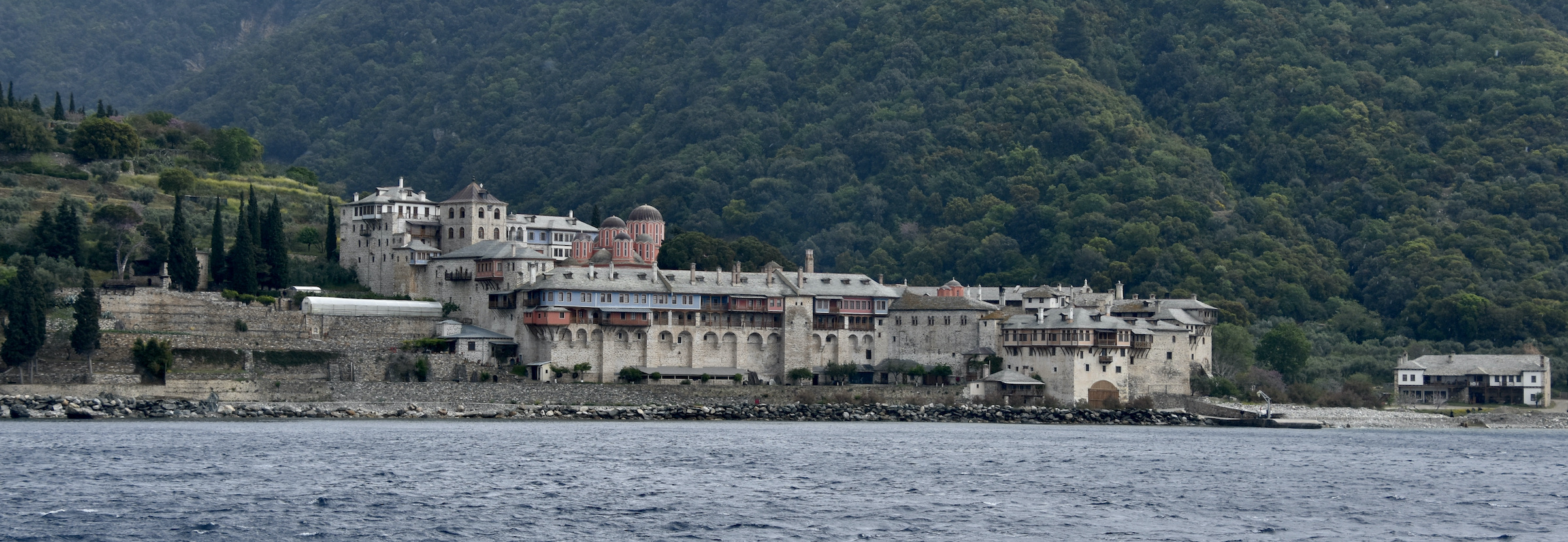
The third Mount Athos monastery is not Greek Orthodox, but rather Russian, something fairly obvious once you see the onion domes. St. Panteleimonos was founded over 1,000 years ago, but most of what you see today dates from the 18th and 19th centuries. Parts of it actually look like they could be resort buildings. At one time over 1,440 monks lived here. Today there are less than fifty, but the way thing are going in Russia becoming a monk on Mount Athos looks a lot better than being used as cannon fodder in the war on Ukraine. Unlike the first two monasteries, it has no website and no direct connection to the outside world.
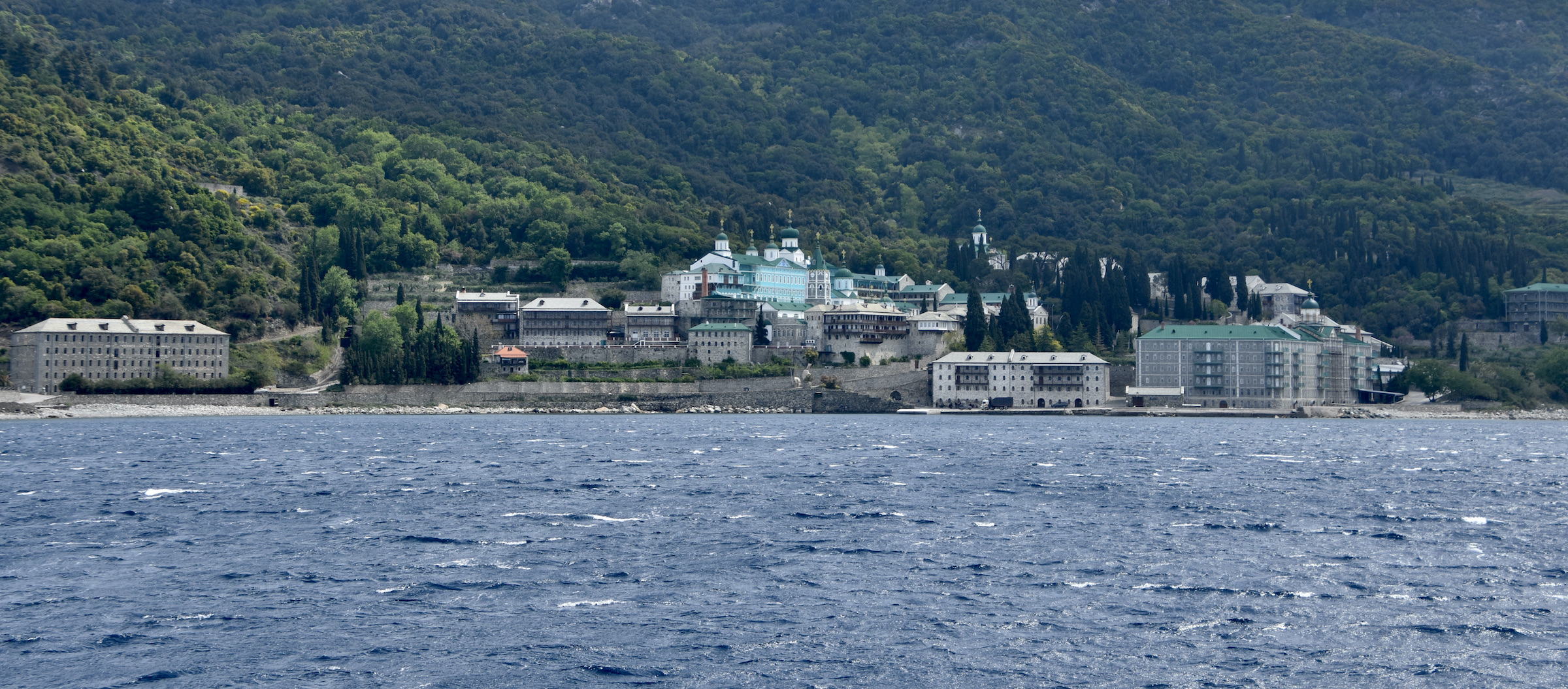
All of the monasteries on Mount Athos are what is referred to cenobitic which simply means the monks live together following a common set of rules and rituals. The opposite of cenobitic is eremitic which means the monks live alone as hermits. At one time there were a lot of eremites on Mount Athos living in caves or simple huts. At first I thought this structure high up on the side of a wooded hill might belong to one of these hermits, but on reflection it’s far too large to be a single person dwelling and is what is referred to as a kellion aka cell in which two or three monks would be engaged in one type of activity or another.
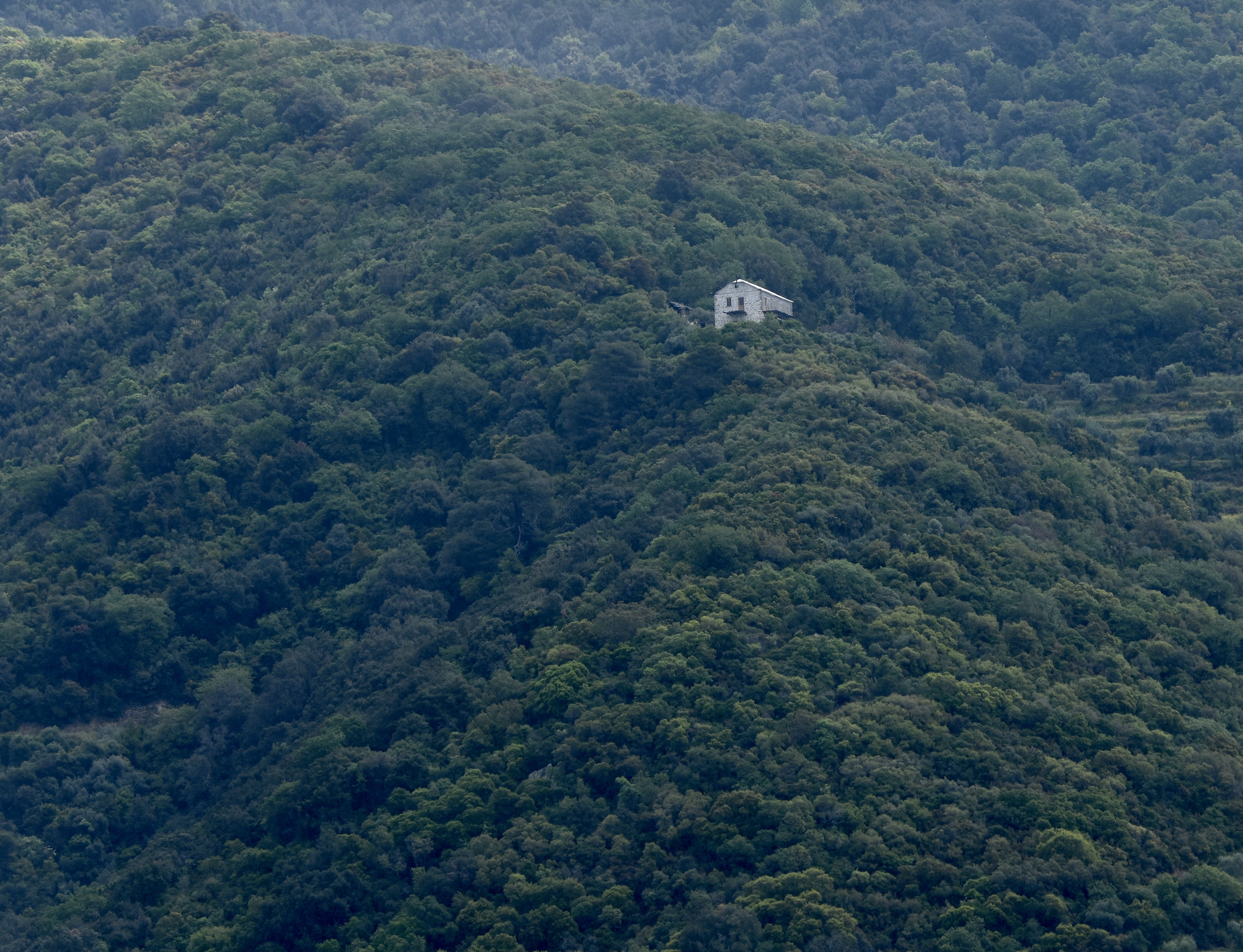
The next monastery is the first active one that does not front directly on the Aegean. Xiropotamou is one of the oldest monasteries on Mount Athos, founded by a monk of that name some time in the 10th century. If you believe in the authenticity of holy relics and of course are an adult male, you’ve got to visit this place. It has the largest known piece of the true cross along with one of the nails. If that isn’t enough, how about some cloth that covered Jesus’ body and part of the Crown of Thorns? If you are, God forbid, a skeptic, then perhaps just waving as you go by is enough.
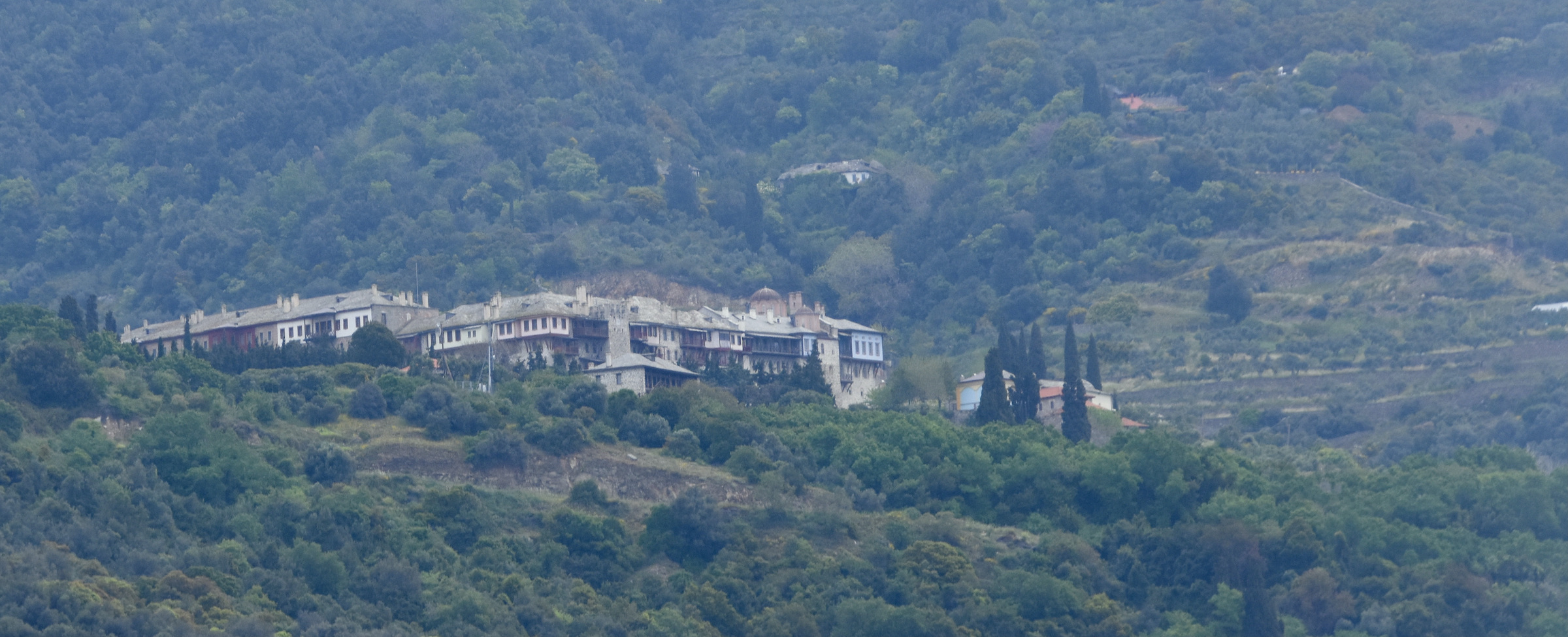
The next group of buildings is not a monastery, but the port of Dafni at which daily ferries arrive from Ouranoupoli along with the occasional supply boat. Here is where visitors to Mount Athos who have received permission to come ashore are landed. Up to 100 Orthodox and 10 ordinary Joes are permitted to land each day. If the name sounds familiar, it’s a variation of the name Daphne, the nymph famously turned into a laurel tree to avoid the pursuit of Apollo. It’s one of the oldest of Greek myths and a very popular subject for artists and sculptors.
No monks live in Dafni, but a number of lay people do. You’ll find a post office, police station, customs house, several stores, a small pension and even a taverna.
If you are interested in visiting Mount Athos you find the instructions by clicking on this link.
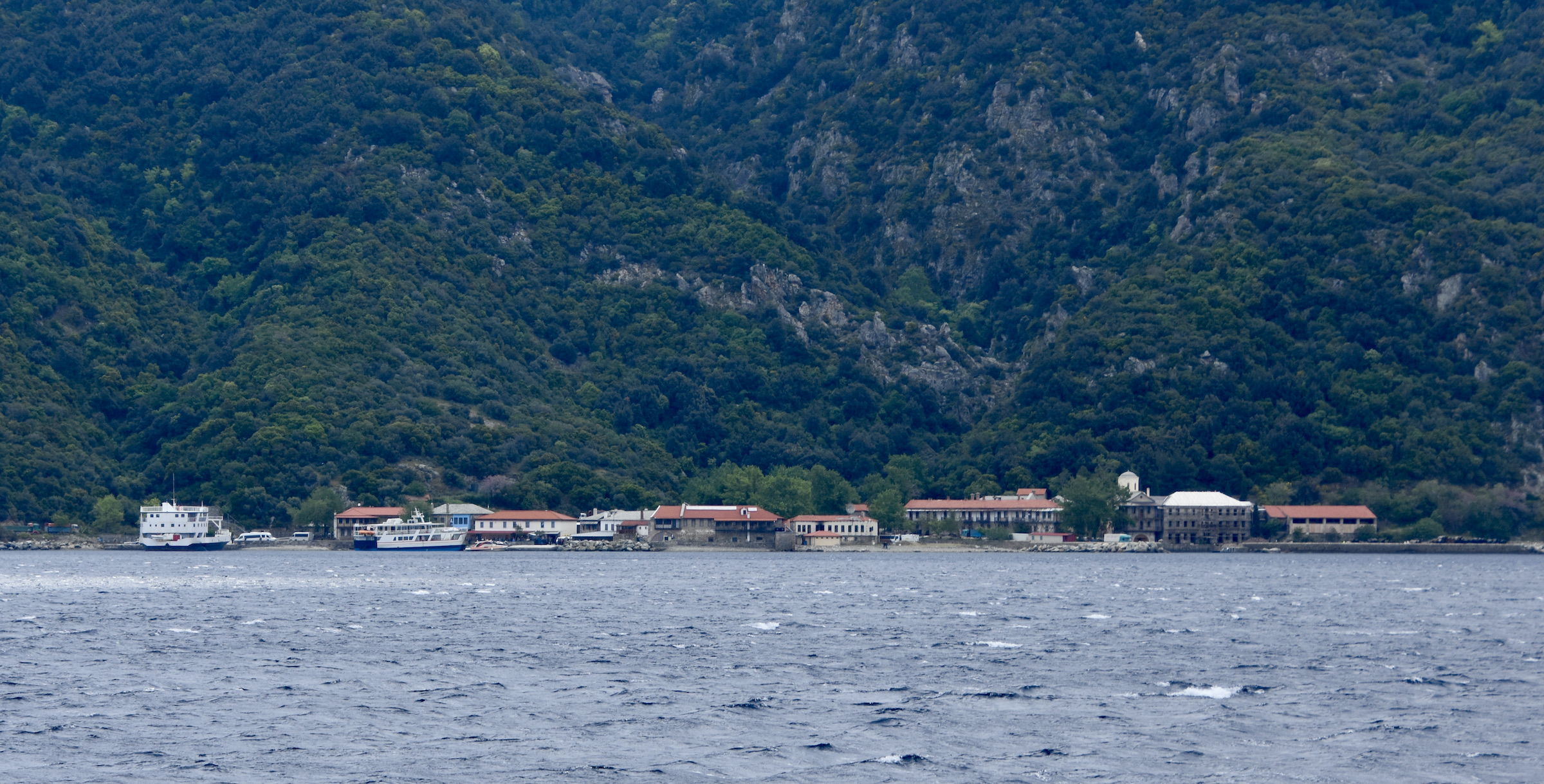
This next group of buildings looks more like a villa than a religious structure, but I believe it is actually what is referred to on Mount Athos as a skete which is a smaller monastic settlement affiliated with a larger monastery.
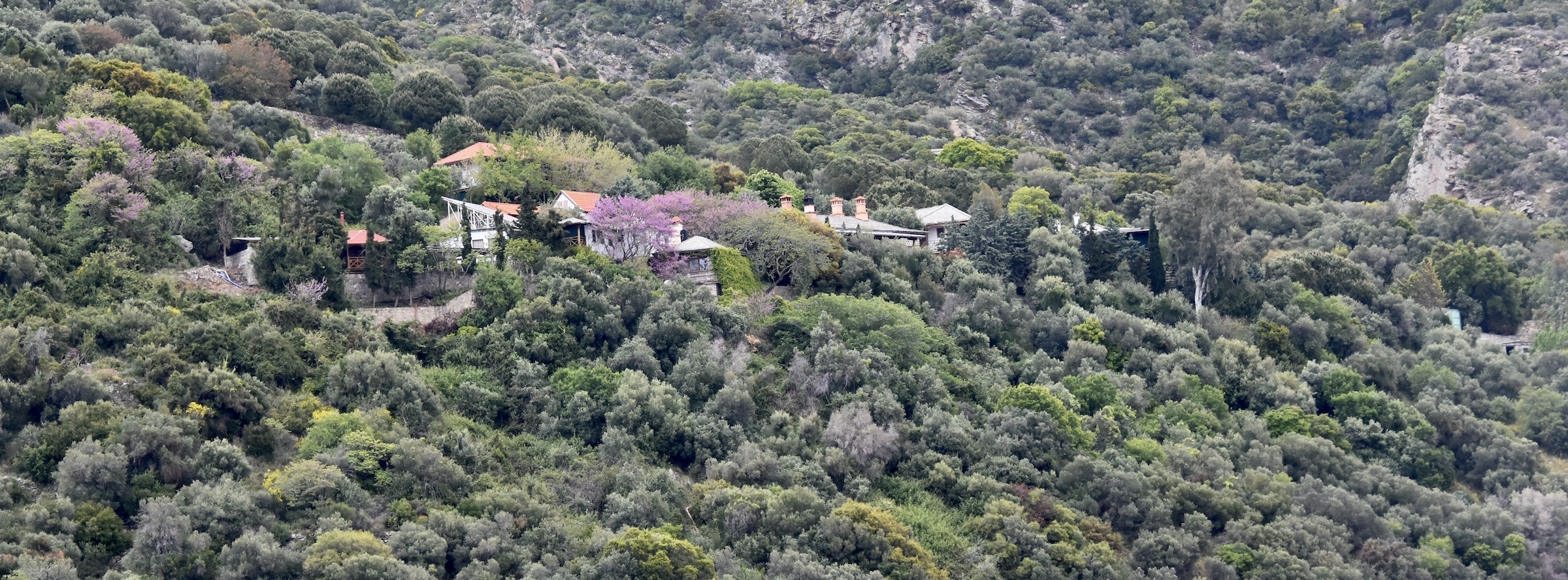
Once past Dafni the landscape begins to get a lot steeper with cliffs coming right down to the sea, the perfect setting for the monasteries we’ve all come to see starting with the most famous, Simonopetra. Founded by St. Simon in the 13th century it has amazed people for hundreds of years and has survived numerous fires including a disastrous one in 1891 in which almost all of the monasteries icons, relics and manuscripts were lost. In the 20th century it came very close to being abandoned and was only saved when a group of monks from Meteora arrived and saved it. We will visit Meteora later on this trip and you will see why Simonopetra was a perfect fit for monks from that place. Today there are roughly 60 monks living here, many of them quite young.
This is one of the monasteries that every tourist most wants to see and while I had thought its main building rose straight over the sea as most photos insinuate, it is still a pretty amazing structure.
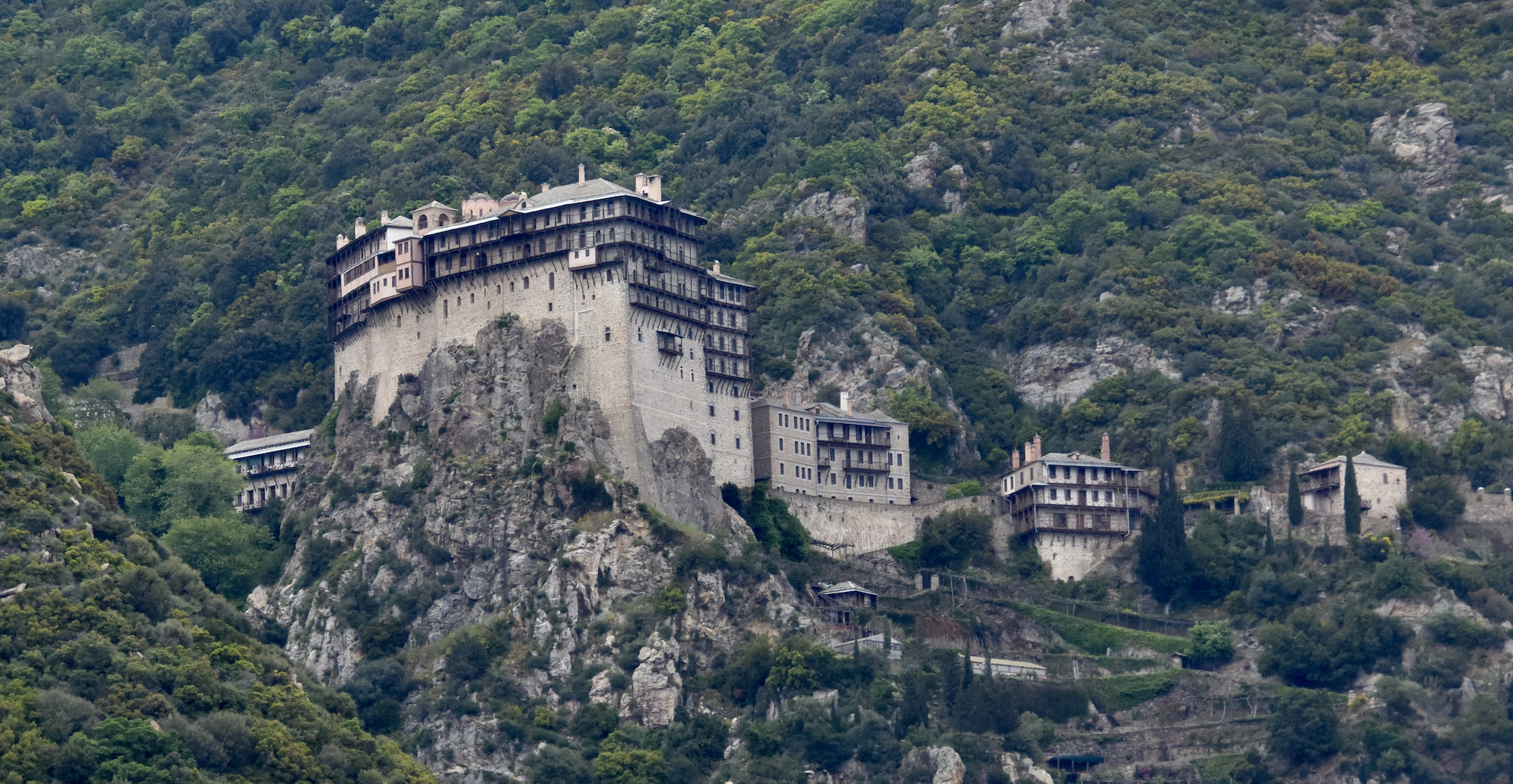
Next up was not another monastery, but Gravanistis waterfall, one of a number on Mount Athos.
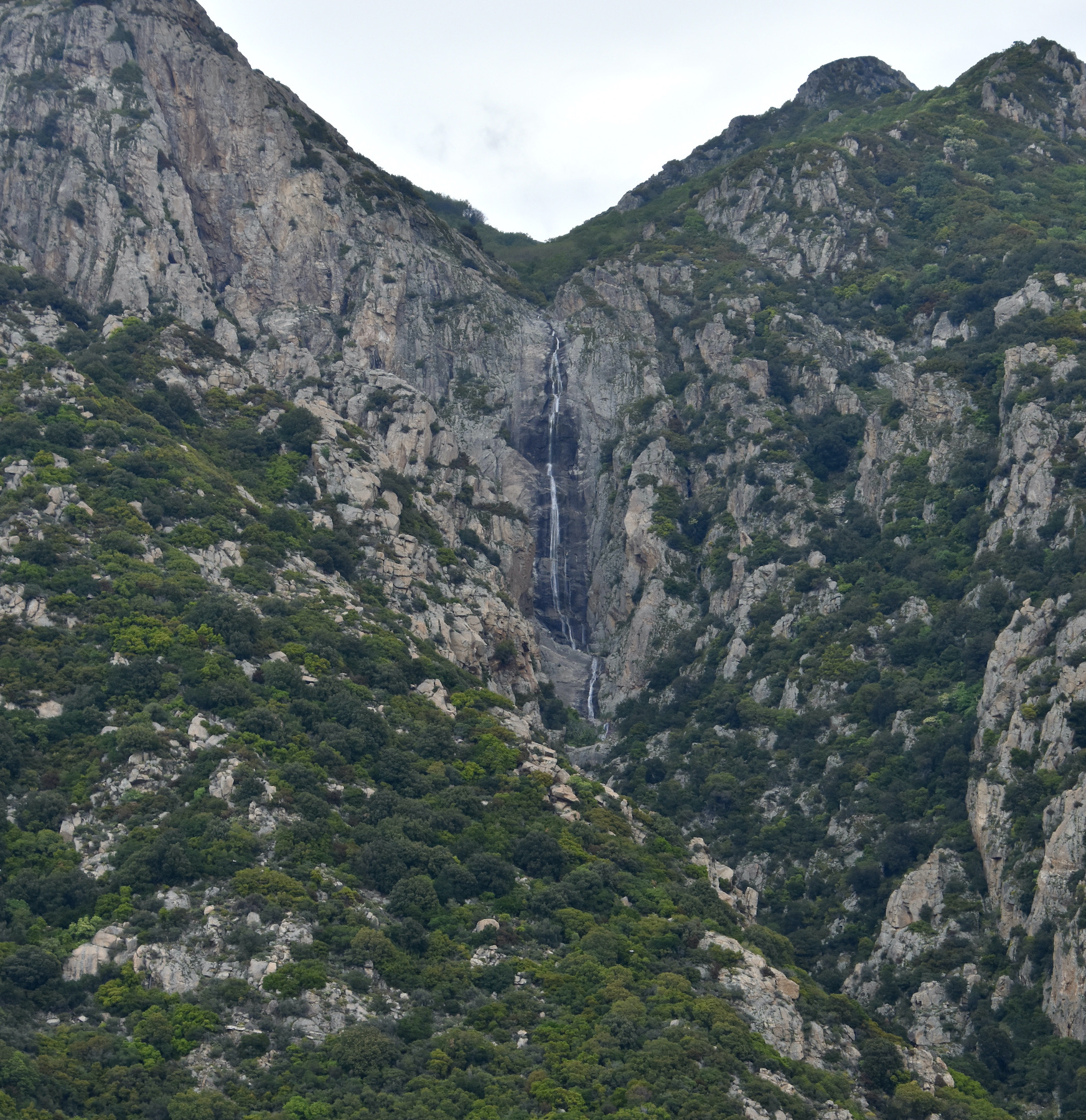
Next we have one of the newest and most populated of the monasteries, Grigiriou or Monastery of St. Gregory. It was founded by the saint of that name in 1310-1314 and thus is ‘only’ 700 years old. It is one of six monasteries on Mount Athos that were built ‘on the rocks’ specifically to discourage the raids by pirates that were so devastating to the seaside monasteries. The other five are of course Simonopetra which we’ve already seen, Dionysiou and St. Paul which are coming up and Pantocrator and Stavronikita which we will not see as they are on the eastern side of the Mount Athos peninsula. This monastery has over 100 monks who are producing incense with such intriguing aromas as Byzantine, Sparta and Cherubic as well as soaps and a number of publications.
For some reason I missed taking a photo of Grigiriou so this one is a public domain one from the web.
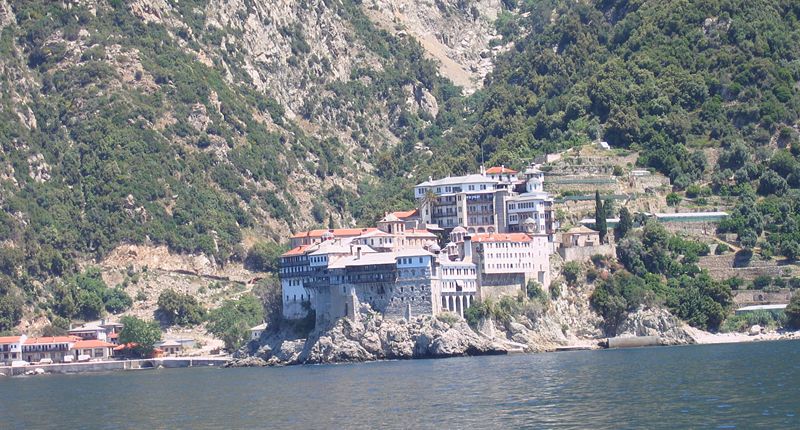
The next to last monastery on the tour was Dionysiou, founded in the 14th century by St. Dionysius of Korisos. Note the small building high above the rest of the monastery which I believe is a kathisma which only one monk would occupy. They are places of reflection usually found quite close to the monastery.
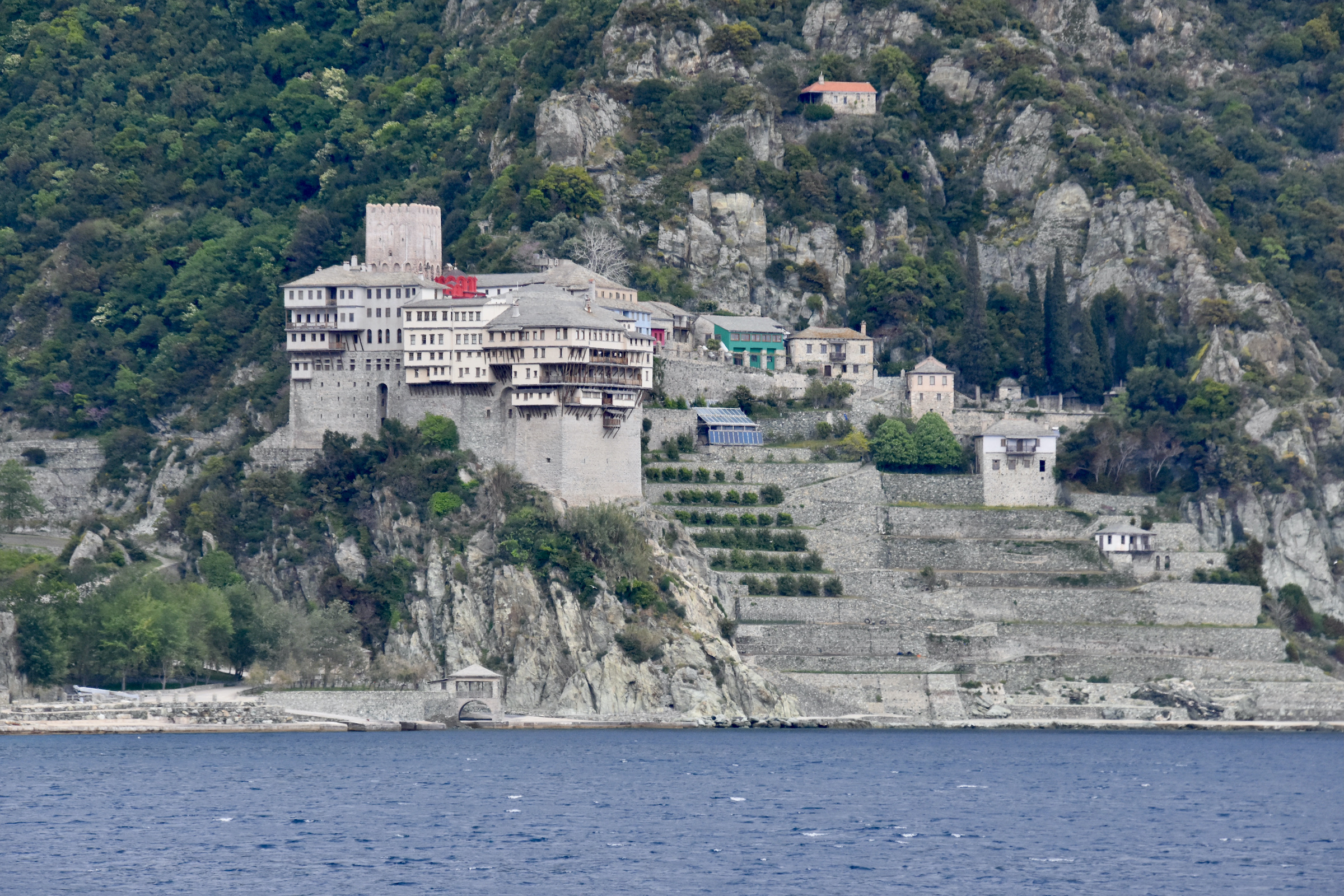
The last monastery on the western side of Mount Athos peninsula is that of St. Paul which is literally on the flank of Mount Athos which rises from the valley directly behind it. Unfortunately by the time we reached it the weather was quite misty and thus this somewhat blurred photo.
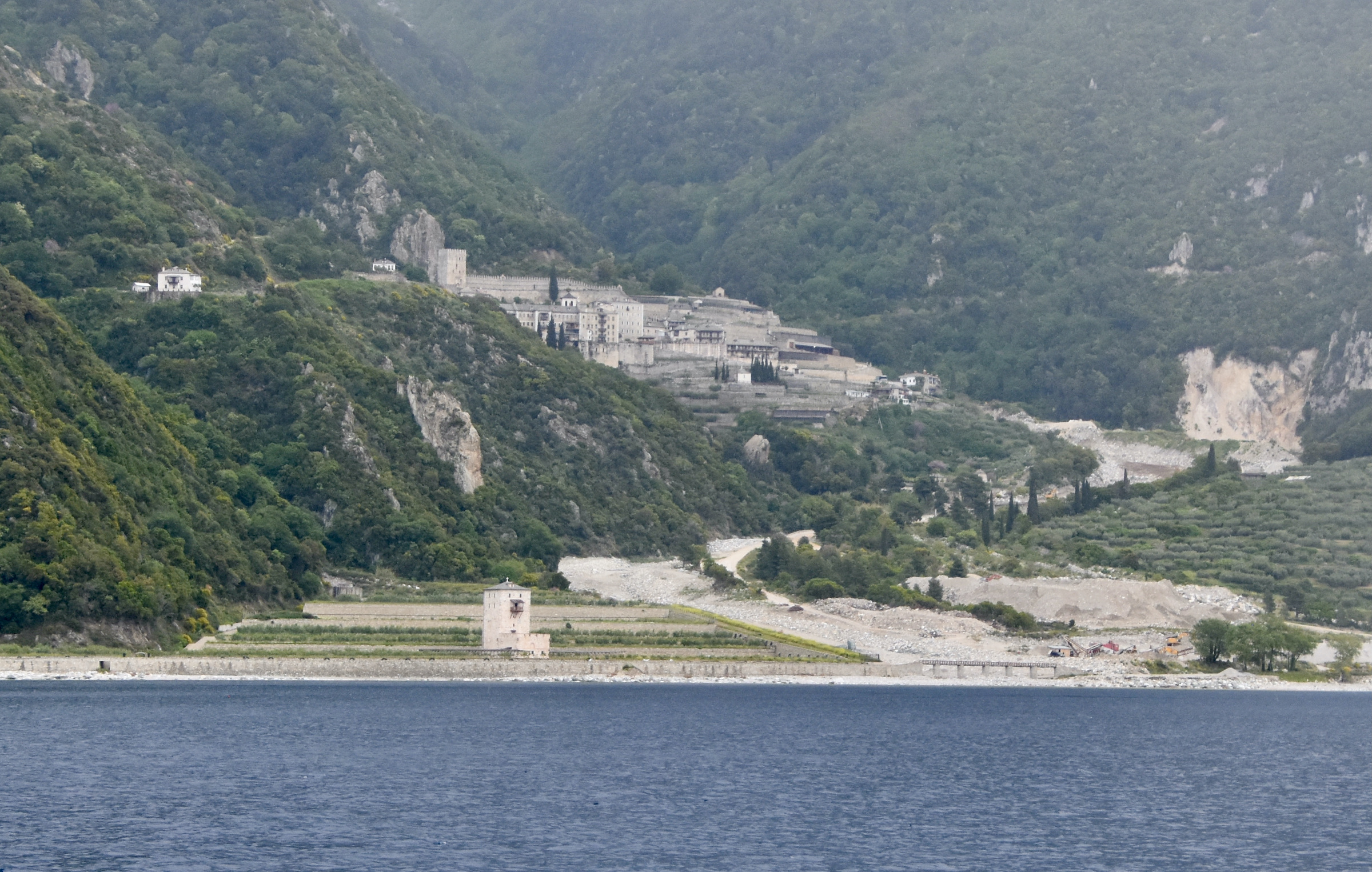
We were now coming close to the tip of the Athos peninsula and after countless fruitless efforts to get a decent photo this was the closest I came. The Holy Mountain refused to show his head. Even so it was a magnificent sight and well worth weathering the weather to get here. BTW the white spots are snow, not water.
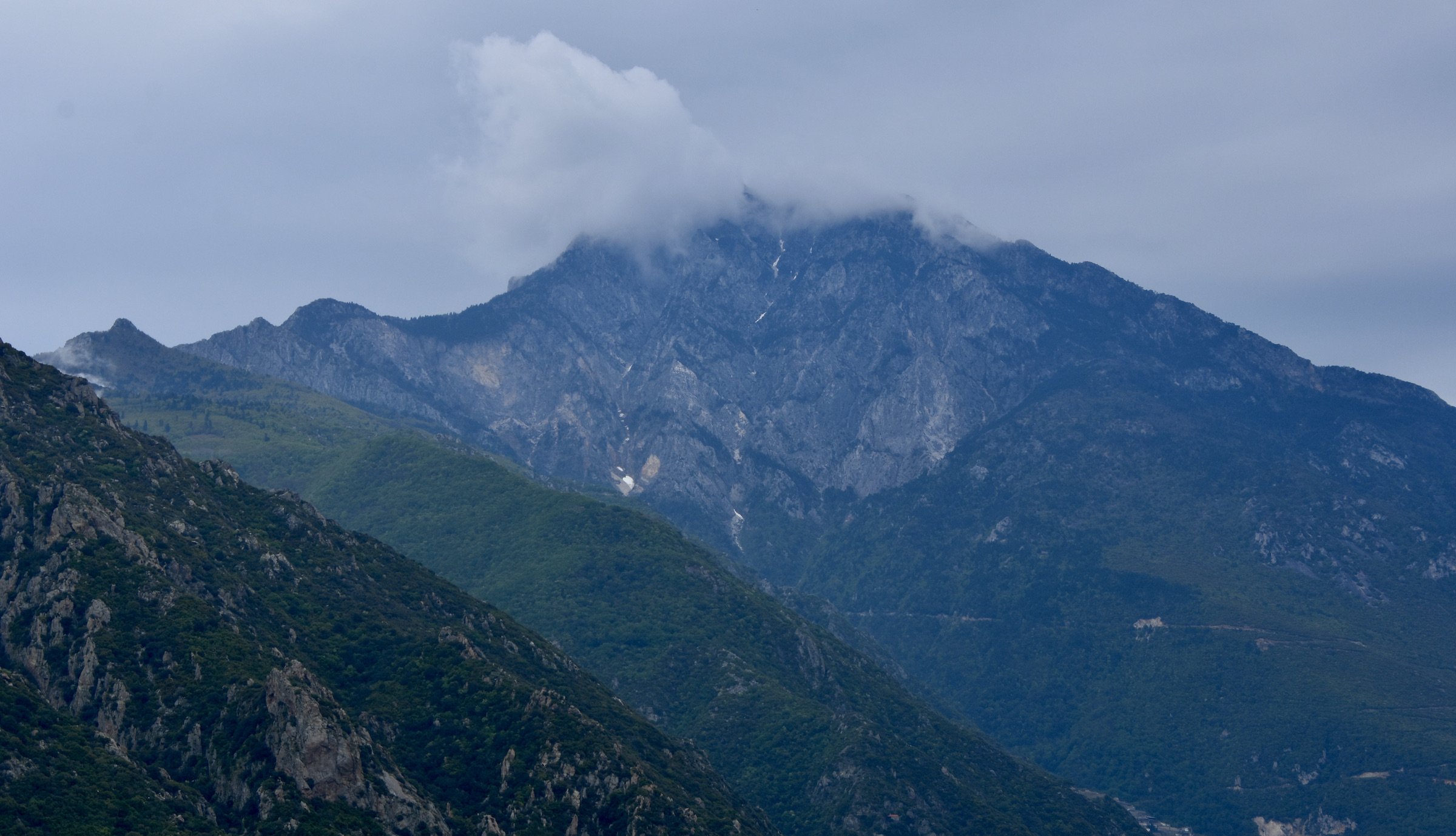
We returned at a faster pace than we had going out and I think most were happy to grab a hot chocolate or coffee and enjoy the ride back, especially Victor whose knee was acting up after a recent mishap. Northing a few beers wouldn’t fix.
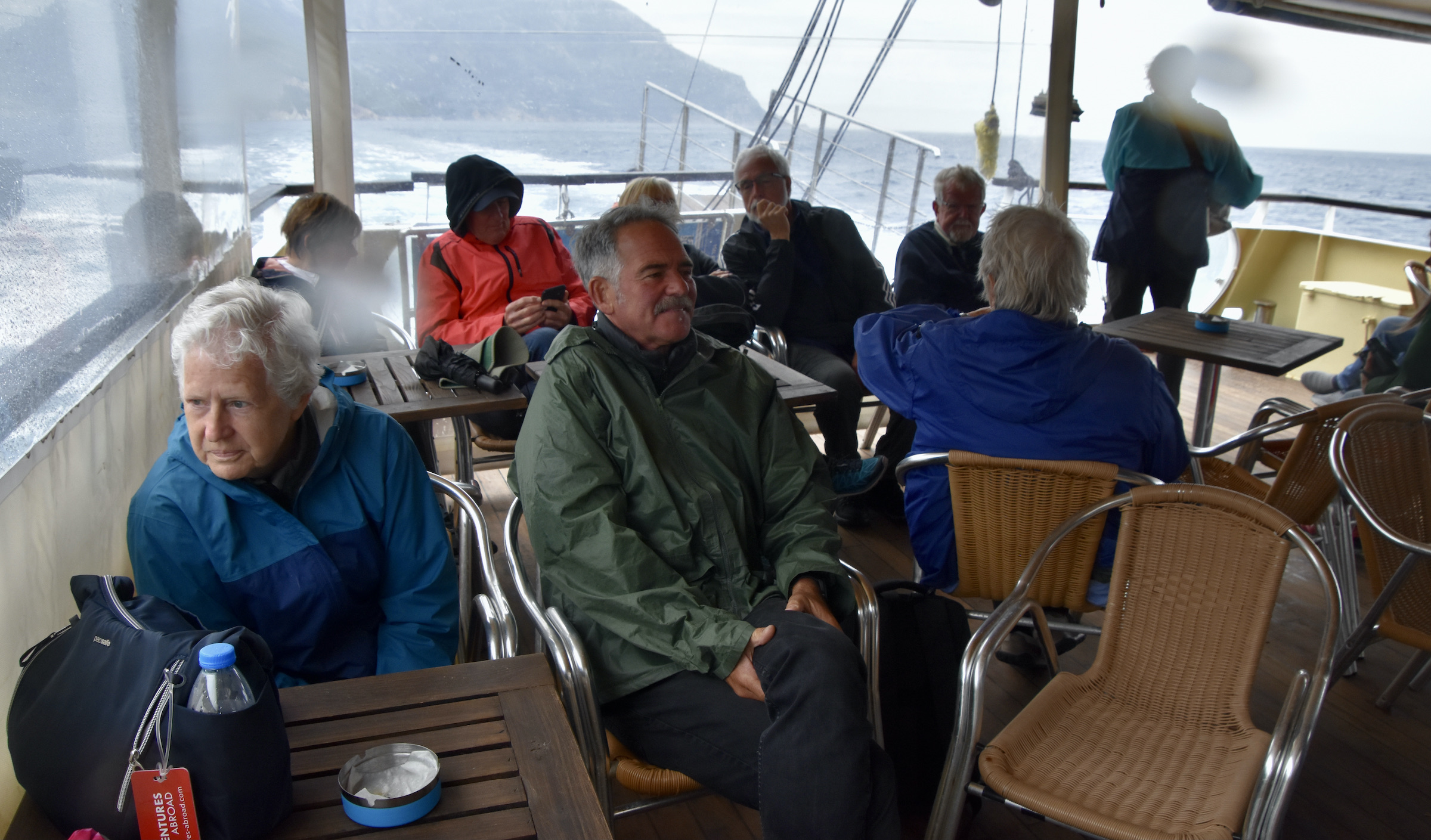
Not me. I joined the gulls that were following the boat.

And stayed outside most of the way back as well.
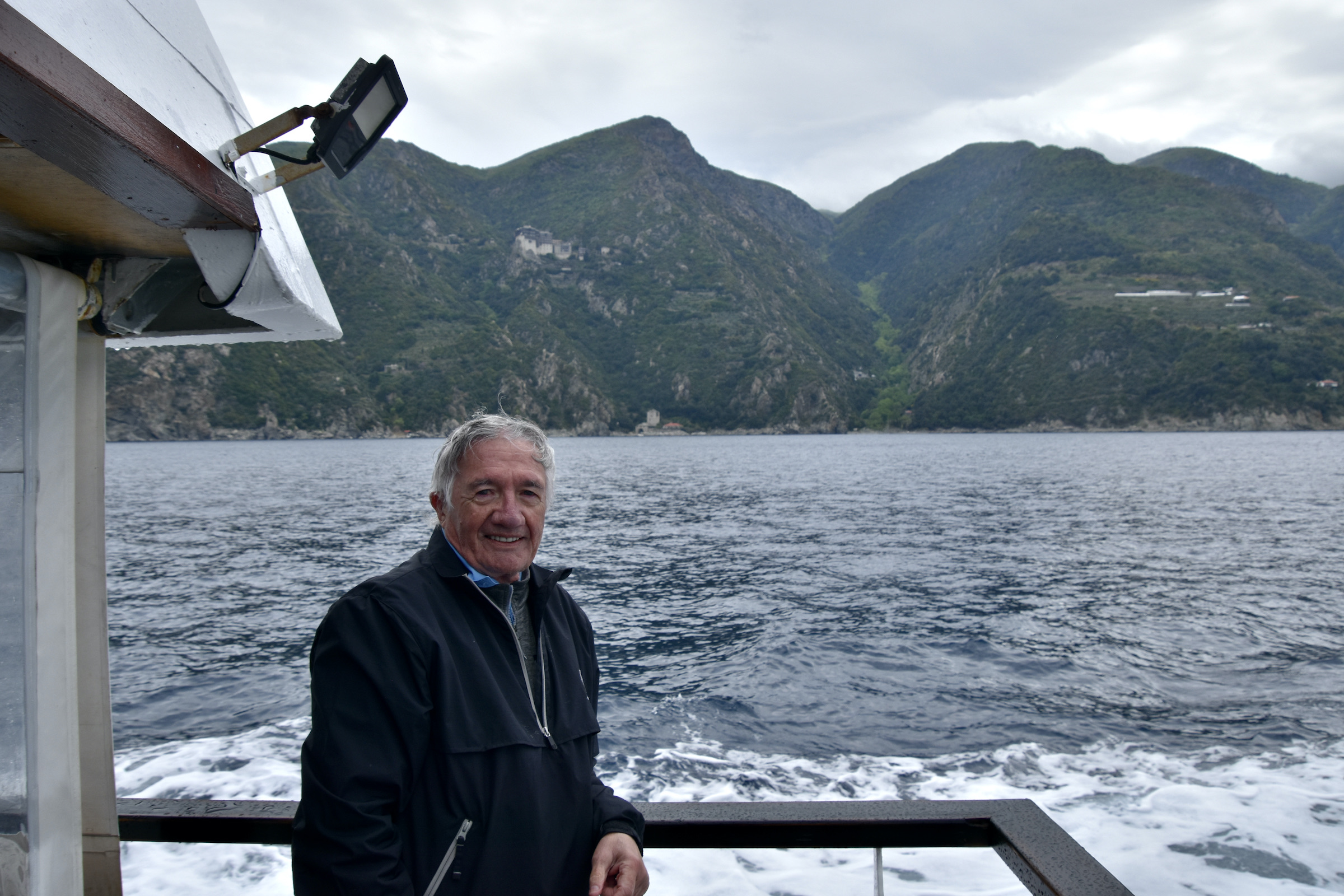
If you want more detailed information about Mount Athos and its various monasteries this website on the Holy Mountain is a terrific resource.
In the next post we’ll arrive at Greece’s second city Thessaloniki, a place steeped in so much history than I can barely cram into one post. Please join us as we spend some quality time in the city where Kemal Ataturk was born.

